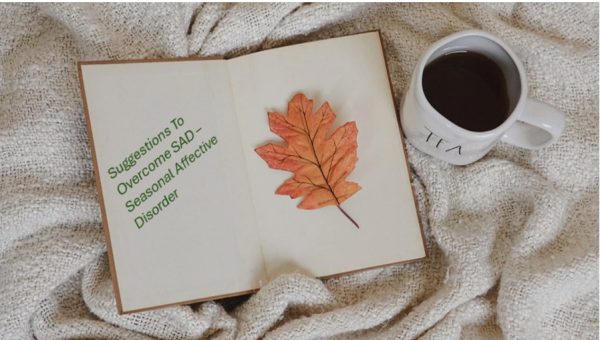
Suggestions To Overcome SAD Seasonal Affective Disorder
As fall and winter seasons approaching, we might start experiencing less energy, low interest, and mood changes. Blame it on shortening days and less sunlight availability! Seasonal Affective Disorder (SAD) is a type of depression that occurs at a specific time of year, usually during the winter months when daylight hours are shorter. SAD is linked to the reduced exposure to sunlight, which can affect a person’s biological clock and lead to mood changes. The key difference between SAD and other forms of depression is its seasonal nature.
Women are more likely to be diagnosed with SAD than men, though men may experience more severe symptoms. The reasons for this gender difference are not fully understood but may involve hormonal factors. People with reduced activity of serotonin, a brain chemical (neurotransmitter) that affects mood, are more susceptible to SAD. Lack of sunlight for many days, cloudy days and darker days can decrease serotonin activity, leading to mood disruptions.
People with low levels of vitamin D, which is produced in response to sunlight, may have a higher risk of developing SAD. Vitamin D plays a role in serotonin production and overall mental health. SAD usually starts and ends at the same time each year, with symptoms appearing in late fall or early winter and easing up in spring or summer. However, a small percentage of people may experience SAD in the summer months, though this is less common.
What symptoms SAD exhibit in a person?
- Feeling depressed most of. the day
- Loss of interest in activities you once enjoyed.
- Low energy and fatigue
- Sleep disturbances could be often oversleeping.
- Difficulty concentrating
- Changes in appetite or weight, craving for carbohydrates.
- Feeling hopeless or worthless
- Social withdrawal
How to overcome Seasonal Affective Disorder:
Light therapy: A common treatment for SAD is light therapy. You can buy a lightbox that mimics sunlight and sitting in front of it for 20-30 minutes each morning may help regulate your body’s sleep-wake cycle and improve mood.
Maximize exposure to natural light: Get outside during daylight hours, even on cloudy days. Natural light, even when limited, can be beneficial. Take walks, sit near windows, or open your curtains wide.
Exercise regularly: Physical activity can boost your mood by increasing the production of serotonin and endorphins. Even light exercises such as walking, yoga, or stretching can help.
Maintain a consistent sleep schedule: Go to bed and wake up at the same time every day to help regulate your internal clock. Aim for 7-9 hours of sleep per night and avoid sleeping too much.
Eat a healthy diet: Focus on a balanced diet with whole grains, lean proteins, fruits, and vegetables. Avoid excessive sugary foods or refined carbohydrates, as they can lead to mood swings. Foods rich in omega-3 fatty acids, vitamin D, and magnesium may help improve mood.
Vitamin D supplements: Since sunlight exposure is limited during winter, you might consider taking vitamin D supplements if levels are low. Low levels of vitamin D are often linked to depressive symptoms.
Practice stress management: Techniques such as meditation, deep breathing, progressive muscle relaxation, or journaling can reduce stress and improve mood.
Socialize and stay connected: Spend time with family and friends, even if you do not feel like it. Isolation can worsen SAD symptoms, so try to maintain your social network. Organize party, attend gatherings, host activities, and invite people home.
Psychotherapy: Also known as Cognitive-behavioral therapy (CBT) has been shown to be effective in treating SAD. It helps by addressing negative thought patterns and behaviors associated with the disorder.
Aromatherapy: Essential oils such as lavender, chamomile, sandalwood, patchouli, or citrus can have mood-boosting properties. Using a diffuser or applying these oils can promote relaxation and emotional well-being.
Create a bright environment: Use brighter bulbs indoors, keep your living and working spaces well-lit, and decorate with bright colors, use bright shades for curtains to create an uplifting atmosphere.
Indoor plant care: Grow indoor plants and take care of them. Greenery inside house helps to create a tropical environment that brightens the day.
These suggestions found be effective for those suffering from SAD. Creating environments that helps us to visualize summer days will help to overcome this disorder.
Image credit: Image by Deborah Hudson from Pixabay (Free to use under Pixabay content license)
Author: Sumana Rao | Posted on: October 4, 2024
« Simple life changes can help you to get rid of under eye bag Ideas For Hosting Diwali Party »






















Write a comment